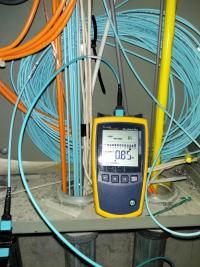Faster and Easier MultiFiber Pro Optical Fiber Tester
May 19, 2016 / General, Installation and testing, Upgrading and troubleshooting
Guest writing for our blog this week is Mike Pennacchi, the owner and lead network analyst for Network Protocol Specialists, LLC. Mike has over 16 years experience as a full time troubleshooting consultant and trainer with a specialty centering around TCP/IP, packet analysis, and network troubleshooting. Mike also teaches Fluke Networks Certified Cabling Test Technician™ (CCTT) two-day training and certification program that aims to improve installers' effectiveness and productivity on the job in testing, certifying and troubleshooting cabling systems.
I recently assisted with the installation and testing of an MPO fiber backbone for a customer, carefully measuring existing lengths with an OTDR and ordering all preterminated MPO cables to length. One of the biggest concerns was that we didn't want to damage any of the cables during pulling--we were faced with runs that ranged from 75 to 200 meters with some of them being pulled through multiple closets.
We also wanted to make sure that the cables we received from the manufacturer fell within the loss that they specified. Thankfully I was asked to try out the Fluke Networks MultiFiber™ Pro Optical Fiber Tester, the first MPO tester to support testing MPO fiber trunks without fan-out cords.
Once we tested all of the cables and verified the loss, we used the MultiFiber Pro to test the cables during the installation, as well as after. This allowed us to test the ends after any major pull--we didn't want to find out after everything was fully installed that the connectors or cables had been damaged. It gave us the chance to find out immediately if we needed to get someone in to do any necessary splicing (a cost that would have come out of our pockets).
While luckily none of the MPO cables were damaged anywhere along the path, it was the MultiFiber Pro that made all the difference. I had never used one before, and it was very intuitive. Testing all fibers of an MPO simultaneously was far easier than using a fan-out cord that separates a 12-fiber cable into single fiber channels, which would have required complicated and time consuming testing of all six pairs on both ends. Instead, I texted my technician in the computer room and let him know which cable I was testing and we simply moved from MPO to MPO. It was a breeze!
One thing to remember with these cables (or with any preterminated cable for that matter) is that just because it comes with a dust cap on it, that doesn't mean it's clean and you can just plug them in. That's where the FiberInspector Pro and OneClick MPO cleaner were essential. We were able to easily see the dirty end faces straight from the manufacturer, use the OneClick cleaner and then verify each connector for cleanliness. Because all it takes is a little dirt and the next thing you know, the network isn't working properly.
I can honestly say that Fluke Networks has made MPO testing faster and easier--idiot proof in my opinion.




